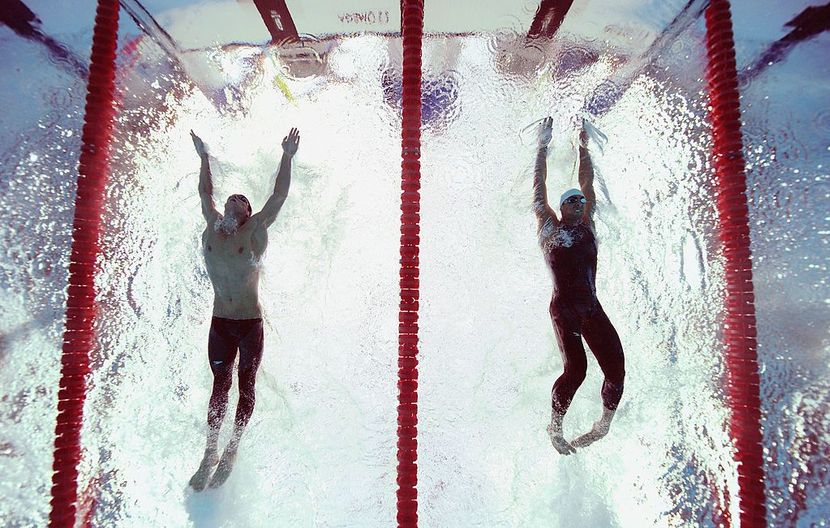
Following six days of swimming highlighted by 13 world records, the 16th World Swimming Championships in Melbourne last December ended with a show-stopping finale: the Men’s 4x100m Medley Relay.
Three teams – Australia, Italy, USA – separated themselves from the field by swimming below the World Record. Coming down the final length of the pool, Australia’s Kyle Chalmers overhauled Italy’s Alessandro Miressi by the smallest of margins. He then drew level to the American anchor, Kieran Smith.
The final metres to the finish were furious. To the naked eye, it couldn’t be closer.
OMEGA’s timekeeping services showed just how tight the finish was. When Chalmers and Smith each punched the finishing touchpad, there was no separating them. High-speed video cameras, recording 100 images per second, showed them both stopping the clock in unison.
Both the American and Australian relay teams were awarded a World Record of 3:18.98 as the two quartets shared the top step of the world championship podium.
Training, Technique and Timekeeping | Constant Evolution in World-Class Swimming
As evidenced by the Men’s 4x100m Medley Relay, advances in areas like training technique and tactics have helped athletes swim faster than ever.
With this, the differences separating top athletes have never been narrower. When we look at the timekeeping of our sports, how is OMEGA able to capture swimming performances with this level of precision?
It takes skilled technicians operating equipment accurately to guarantee perfect, flawless service through a championship event. There’s also an innovative gene in the OMEGA DNA, helping them push the boundaries of sports technology. Swimming, in particular, is a core passion of the company.
Here are six areas where OMEGA’s pioneering spirit has advanced timekeeping in swimming.
Starting Blocks
With the very familiar “beep” at the opening of the race, each starting block has an acoustic device that ensures each competitor hears the start signal at the exact same moment. Each starting block is also equipped with a false start detection system to make sure no one jumps the starter’s signal.
There’s even the “swimming light show” mounted on the starting blocks that lets athletes and spectators know the race results – a single dot indicates first place, two dots for second place and three dots confirm the third-place finisher.
Quantum Timer
Having timers standing at the edge of the pool with mechanical stopwatches in hand is a thing of the past. Today, OMEGA counts a swimmer’s performance with an enhanced resolution of its quartz-driven Quantum Timer.
Underwater Lap Counters
Imagine you’re Gregorio Paltrinieri of Italy or Lani Pallister of Australia racing the 1500m freestyle short-course world championship final. With 60 lengths of the pool raced at a lactate acid-burning intensity, even the most astute lap counter could be wondering exactly how long until they finish.
For the longer 800m and 1500m races, electronic lap counters are placed underwater in each lane at the turning end of the pool. These highly visible digital screens allow swimmers to concentrate on their technique, pace, and position in the race, while still being assured of how many laps they have left to swim.
Swim Tracker Systems | Vision Technology that Enables Live Stats & Information
Now here’s where OMEGA’s comprehensive timekeeping services really move into today’s leading-edge technology. Athletes now have a complete suite of performance measures that are recorded by image-tracking cameras placed around the pools.
This information is even fed into live broadcasts of events giving us:
- Live Position (not just as every turn)
- Live Speed
- Athlete Acceleration
- Athlete Deceleration
- Distances and Times Between Swimmers
- Stroke Counts
Now when we watch a fast-paced 100m freestyle, we know the live position of every swimmer in the water. When we watch the 100m butterfly, we now know the number of strokes a swimmer takes and how fast each one accelerates when they push off. This captured data gives athletes and coaches essential information to understand how each race was won or lost. This data is also fed into the commentator information systems, giving broadcasters real-time insights that they describe to viewers watching the race.
Swimming Touchpads
Touchpads are a perfect example of OMEGA’s long-standing commitment to pushing for new technological boundaries.
Touchpads were borne out of necessity following controversy at the Rome 1960 Olympic Games when two athletes recorded the exact same time – measured by an aggregate time of three judges with hand stopwatches. One athlete, Australian John Devitt, was awarded the gold medal and the other one, Team USA’s Lance Larson, received the world record. Following this, World Aquatics approached OMEGA to develop a technology that eliminated human uncertainties. Since being introduced in 1967, touchpads have proven to be the most precise way to measure time in swimming. They have been used at every World Aquatics Championships and at the Olympic Games since Mexico City in 1968.
High-Speed Cameras
Nothing is more intense than a race coming down to the wire. When the result is super close, judges consult OMEGA’s high-speed cameras.
This technology was famously put to the test at the Beijing 2008 Olympic Games when the electronic timing system determined – and the high-speed cameras confirmed – that Michael Phelps out-touched Milorad Cavic by a hundredth of a second, the smallest possible margin of winning in swimming.